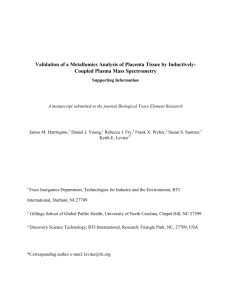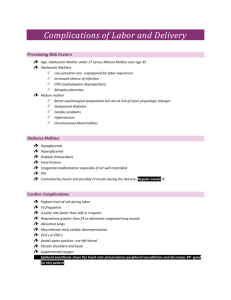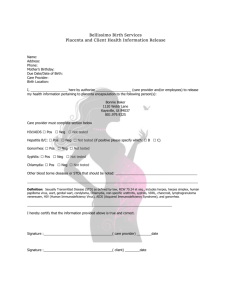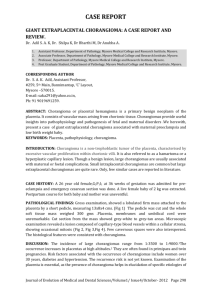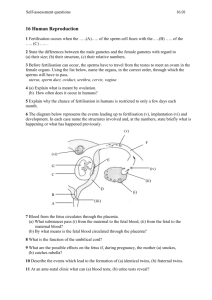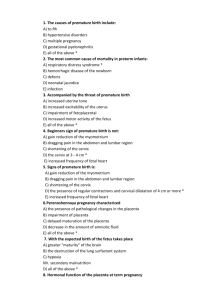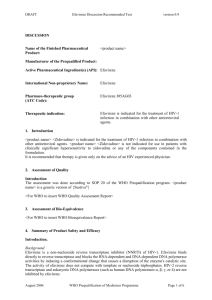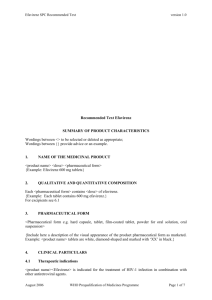Introduction Efavirenz is non nucleoside reverse transcriptase
advertisement
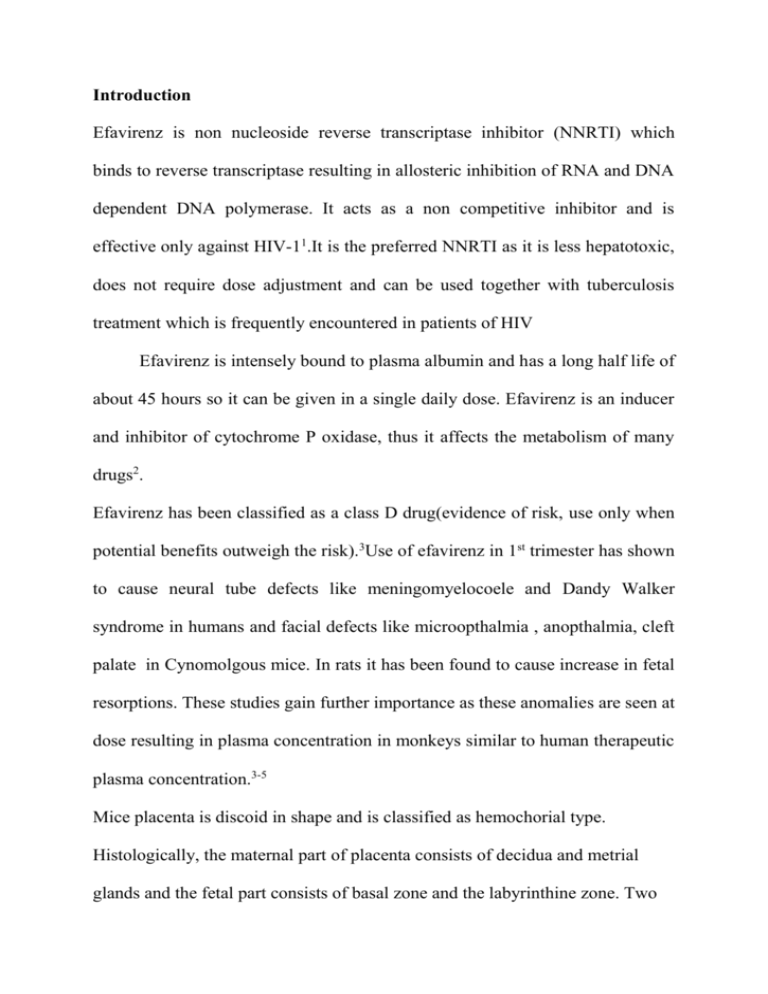
Introduction Efavirenz is non nucleoside reverse transcriptase inhibitor (NNRTI) which binds to reverse transcriptase resulting in allosteric inhibition of RNA and DNA dependent DNA polymerase. It acts as a non competitive inhibitor and is effective only against HIV-11.It is the preferred NNRTI as it is less hepatotoxic, does not require dose adjustment and can be used together with tuberculosis treatment which is frequently encountered in patients of HIV Efavirenz is intensely bound to plasma albumin and has a long half life of about 45 hours so it can be given in a single daily dose. Efavirenz is an inducer and inhibitor of cytochrome P oxidase, thus it affects the metabolism of many drugs2. Efavirenz has been classified as a class D drug(evidence of risk, use only when potential benefits outweigh the risk).3Use of efavirenz in 1st trimester has shown to cause neural tube defects like meningomyelocoele and Dandy Walker syndrome in humans and facial defects like microopthalmia , anopthalmia, cleft palate in Cynomolgous mice. In rats it has been found to cause increase in fetal resorptions. These studies gain further importance as these anomalies are seen at dose resulting in plasma concentration in monkeys similar to human therapeutic plasma concentration.3-5 Mice placenta is discoid in shape and is classified as hemochorial type. Histologically, the maternal part of placenta consists of decidua and metrial glands and the fetal part consists of basal zone and the labyrinthine zone. Two layers of membrane enclose the placenta, the outer yolk sac and the inner amnion.6, 7 Placenta plays an important role in pregnancy, facilitating exchanges of different substances between maternal and fetal blood and maternal tolerance of various antigens. Effect of Efavirenz on mice placenta has been taken in this present study as it serves an important interface in the transfer of the drug from mother to fetus. Materials and Methods Ethical clearance was taken from Institutional ethical committee for the present study. Swiss albino mice were taken , kept in polypropylene cages and were fed standard pellet diet and tap water ad libitum. They were kept for mating in the ratio of one male to three female. Vaginal smear was taken on the next day and sperm positivity in it was designated as gestational day 1(GD1).The control group was given distilled water by gavage and the treated group was given efavirenz in doses of 50mg/kg and 100mg/kg from 6th to 15th day of gestation through oral route. The pregnant dams were sacrificed by cervical dislocation on 18th day and uterotomy was done to dissect out the fetuses with placenta. The placenta were cleaned, dried, weighed and kept in 10% formalin for processing. The fixed placenta were cut at 8 µ and stained with hematoxylin and eosin for micromorphological observations. Results On gross observation there was no overt anomaly in the treated placenta but on weighing there was a dose dependent reduction in weight which was statistically significant. On histological observation dose dependent pathological changes were observed in the treated groups. Structural changes observed in the 3 zones of placenta are as followsZone 1(Decidua basalis) – There is no abnormality seen in this zone in the placenta Zone 2(Basal zone) – In the basal zone there appears to be cytolysis of glycogen cells, reduction in the density of spongiotrophoblast and degeneration of trophoblastic giant cell in a dose related manner. Zone 3 (Labyrinthine zone) – In the labyrinthine zone there is fibrin deposition in trichorial membrane resulting in loss of cytotrophoblast and increase in thickness of placental barrier. In the high dose (100mg) lymphocytic infiltration is seen. Discussion The placenta grows rapidly in a short time and has multiple functions to its credit like barrier action, nutritional transport, drug metabolism and hormone secretion. Thus placenta is susceptible to toxic and chemical insults by drugs. On the other hand placenta has intimate relation with mother and fetus and the trio forms a close knit unit in embryonic development. So any injury to placenta is simultaneously reflected on fetus as abnormal development and thus the placenta injury can be used as a marker of fetal toxicity.8 Efavirenz is a very commonly prescribed drug especially in resource limited settings where the drug formulation is scarce, infected women are commonly seen in their reproductive period, coinfection of HIV-1 with tuberculosis is very common and risk of mortality among infected people is high.3 It is a popular drug in third world countries due to its low cost, single dosage a day, safety profile and its better interaction with anti tuberculosis drugs than nevirapine.4 Efavirenz has a high placental transfer rate and is widely distributed in the body.9 Efavirenz has also been shown to increase bioavailability of steroidal hormones during pregnancy when their levels are already high.10 This can lead to toxic levels of these hormone specially estrogen in the blood. Excess estrogen in pregnancy has been shown to cause disruption of trophoblastic septa, haemorrhage, fibrin deposition and inflammatory cell migration in the labyrinth zone of placenta.So the effects on placenta seen with efavirenz can be attributed to decreased metabolism of steroidal hormones leading to estrogen toxicity. There is a positive correlation between placental size and fetal weight in human beings. Thus low placental weight is usually associated with IUGR babies. This is probably due to deficient transfer of sugar from the maternal blood to fetal blood across placenta. Thus efavirenz induced placental insult can give rise to embryotoxicity Conclusion Efavirenz has a detrimental effect on the placenta especially in high doses. As placental development is a reflection of fetal growth it can be hypothesised that efavirenz at high doses can be embryotoxic. References 1. Katzung BG, Masters SB,Trevor AJ.Basic &clinical pharmacology; McGraw Hill publishers,11th eds:p427-30 2. Goodman and Gilman’s. The pharmacological basis of therapeutics, 11 th edition, McGraw- Hill, 2006, p1357-1359 3. Chersich MF, Urban MF, Venter FWD, Wessels T, Krause A. Efavirenz use during pregnancy and for women of child bearing potential. Aids Res Therapy 2006;3: 11-17 4. Clayden P, Black V, Boulle A, Coovadia AH, Venter F. Efavirenz in pregnancy.South Afr J HIV med 2010; 11(2):24-9 5. Ford N, Mofenson L, Kranzer K, Medu L, Frigati L, Mills EJ, Calmy A. Safety of efavirenz in first-trimester of pregnancy: a systematic review and meta-analysis of outcomes from observational cohorts. AIDS 2010; 24(10):1461-70. 6. Furukawa S, Hayashi S, Usuda K, Abe M, Hagio S, Ogawa I. Toxicological pathology in rat placenta. J Toxicol Pathol 2011; 24: 95111 7. Malassine A, frendo JL, Brion DE. A comparison of placental development and endocrine function between human and mouse model. Hum Reprod Update 2003; 9(6):531-39. 8. Mishra A, Singh M. Topiramate induced histopathological changes in placenta of rats. Ind J Exp Biol 2008;46:715-19 9. Cressey TR, Stek A, Capparelli E. Efavirenz pharmacokinetics during third trimester of pregnancy and post partum. J Acquir Immune Defic Syndr 2012; 59(3):245-52 10.WHO. Medical eligibility criteria for medical use .Third Edition,2004 Legends Fig 1- Photomicrograph of control placenta showing basal zone. H&Ex40X Fig 2- Photomicrograph of control placenta showing labyrinthine zone. H&Ex40X Fig 3 – Photomicrograph of 50 mg/kg Efv treated placenta showing fibrin deposition and glycogen cytolysis in basal zone. H&Ex40X Fig 4- Photomicrograph of 50 mg/kg Efv treated placenta showing increased thickness of placental barriers in labyrinth zone. H&Ex40X Fig 5- Photomicrograph of 100 mg/kg Efv treated placenta showing giant cell degeneration and glycogen cytolysis in basal zone. H&Ex40X Fig 6- Photomicrograph of 100 mg/kg Efv treated placenta showing fibrin deposition and lymphocytic infiltration in labyrinth zone. H&Ex40X
